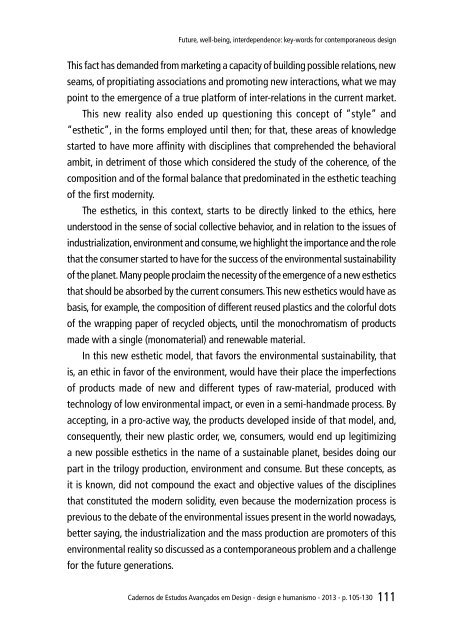o_19po8js951tvs1r0t1r8s4bb1vpla.pdf
You also want an ePaper? Increase the reach of your titles
YUMPU automatically turns print PDFs into web optimized ePapers that Google loves.
Future, well-being, interdependence: key-words for contemporaneous design<br />
This fact has demanded from marketing a capacity of building possible relations, new<br />
seams, of propitiating associations and promoting new interactions, what we may<br />
point to the emergence of a true platform of inter-relations in the current market.<br />
This new reality also ended up questioning this concept of “style” and<br />
“esthetic”, in the forms employed until then; for that, these areas of knowledge<br />
started to have more affinity with disciplines that comprehended the behavioral<br />
ambit, in detriment of those which considered the study of the coherence, of the<br />
composition and of the formal balance that predominated in the esthetic teaching<br />
of the first modernity.<br />
The esthetics, in this context, starts to be directly linked to the ethics, here<br />
understood in the sense of social collective behavior, and in relation to the issues of<br />
industrialization, environment and consume, we highlight the importance and the role<br />
that the consumer started to have for the success of the environmental sustainability<br />
of the planet. Many people proclaim the necessity of the emergence of a new esthetics<br />
that should be absorbed by the current consumers. This new esthetics would have as<br />
basis, for example, the composition of different reused plastics and the colorful dots<br />
of the wrapping paper of recycled objects, until the monochromatism of products<br />
made with a single (monomaterial) and renewable material.<br />
In this new esthetic model, that favors the environmental sustainability, that<br />
is, an ethic in favor of the environment, would have their place the imperfections<br />
of products made of new and different types of raw-material, produced with<br />
technology of low environmental impact, or even in a semi-handmade process. By<br />
accepting, in a pro-active way, the products developed inside of that model, and,<br />
consequently, their new plastic order, we, consumers, would end up legitimizing<br />
a new possible esthetics in the name of a sustainable planet, besides doing our<br />
part in the trilogy production, environment and consume. But these concepts, as<br />
it is known, did not compound the exact and objective values of the disciplines<br />
that constituted the modern solidity, even because the modernization process is<br />
previous to the debate of the environmental issues present in the world nowadays,<br />
better saying, the industrialization and the mass production are promoters of this<br />
environmental reality so discussed as a contemporaneous problem and a challenge<br />
for the future generations.<br />
Cadernos de Estudos Avançados em Design - design e humanismo - 2013 - p. 105-130<br />
111



